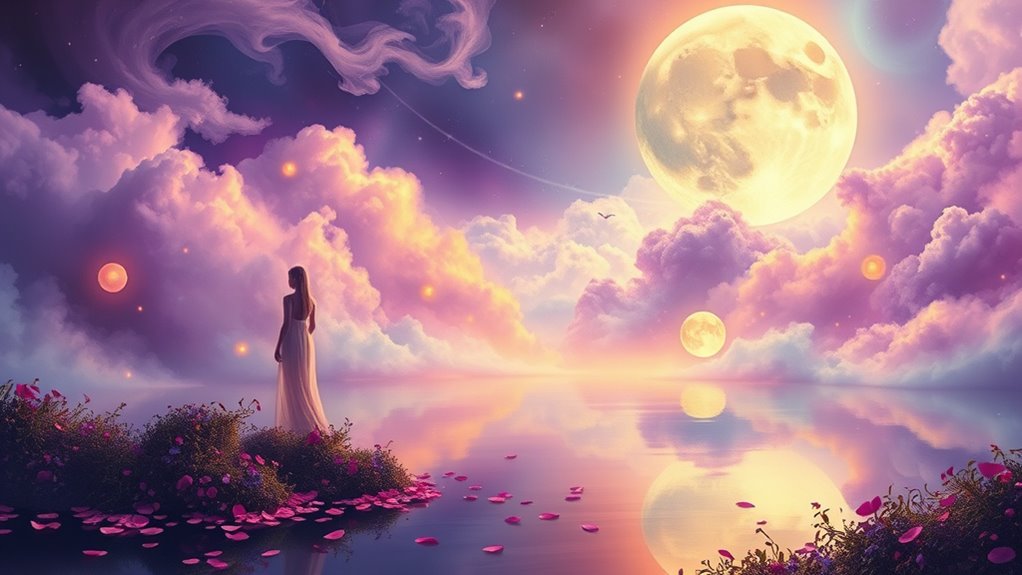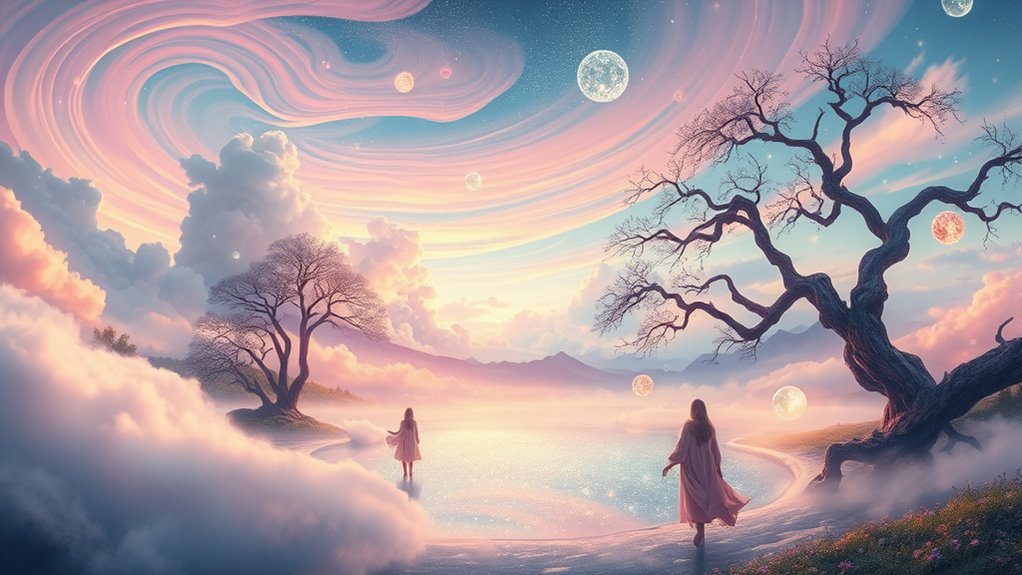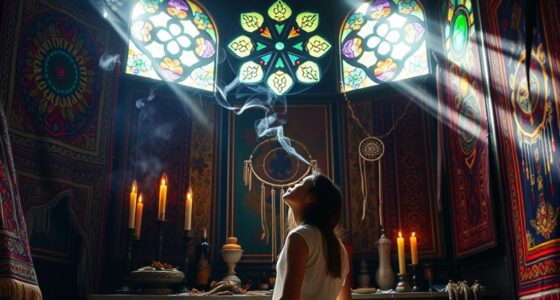Dreams serve as a rich source of artistic inspiration, offering surreal imagery and subconscious symbols that ignite creativity. They let you access hidden emotions, fears, and desires, translating complex inner worlds into powerful art. Surreal visuals and impossible landscapes challenge your perspective and encourage experimentation beyond reality’s limits. By exploring dreams, you can deepen your understanding and create emotionally compelling work. If you explore further, you’ll uncover even more ways dreams can fuel your artistic journey.
Key Takeaways
- Dreams offer vivid, surreal visuals that inspire innovative artistic ideas beyond reality’s constraints.
- Subconscious themes revealed in dreams provide authentic emotional content for creative expression.
- Surreal imagery and symbolism in dreams serve as powerful metaphors for deeper artistic meaning.
- Dream imagery encourages experimental approaches, expanding the boundaries of traditional art.
- Transforming dreams into art fosters a personal connection, adding depth and emotional resonance for viewers.

Dreams have long served as a wellspring of inspiration for artists, offering vivid visuals and surreal narratives that ignite creativity. When you wake up from a dream, you often carry with you a kaleidoscope of surreal imagery—impossible landscapes, floating objects, twisting perspectives—that seem to come from a world beyond ordinary reality. These images can spark your imagination, pushing you to explore new artistic directions. They serve as a bridge to your subconscious themes, revealing hidden emotions, fears, and desires that might be difficult to access during waking hours. By tapping into this well of subconscious material, you gain a fresh perspective that can breathe new life into your art.
As you reflect on your dreams, you’ll notice how the surreal imagery often defies logic, yet it resonates on an emotional level. This disconnect between reality and fantasy allows you to approach your work with a freer, more experimental mindset. You don’t have to conform to the rules of the physical world; instead, you can stretch the limits of imagination and create visuals that challenge viewers’ perceptions. The dream world offers a unique playground where symbolism and metaphor flourish, providing rich material for your artistic interpretation. Whether it’s a floating city, a twisting figure, or an impossible color palette, these surreal elements can become the core of your artwork, giving it a sense of mystery and depth that’s hard to achieve otherwise.
Moreover, dreams often bring subconscious themes to the surface—hidden stories, unspoken feelings, unresolved conflicts—that you can channel into your art. This process allows you to access parts of yourself that are normally buried beneath daily routines and conscious thought. When you translate these themes into visual form, your work becomes more authentic and emotionally charged. It’s like entering a dialogue with your inner self, where symbols and images act as language. Incorporating subconscious themes into your art not only enriches its meaning but also creates a more visceral connection with your audience, who may recognize their own hidden truths reflected in your work. Additionally, understanding the role of dream symbolism can help deepen your artistic expression by providing insight into the meanings behind recurring images.
Ultimately, your dreams provide an endless source of inspiration that can elevate your artistry. The surreal imagery you experience and the subconscious themes you uncover serve as catalysts for innovation and emotional expression. By paying attention to these nocturnal visions, you open yourself to new creative possibilities and deepen your understanding of your inner world. In doing so, you transform fleeting dreams into compelling works of art that resonate long after you wake up.
Frequently Asked Questions
Can Dreams Predict Future Artistic Trends?
Dreams can hint at future artistic trends through dream analysis, revealing subconscious influences that inspire innovative ideas. You might notice recurring themes or symbols in your dreams, guiding your creative direction. While dreams don’t predict trends with certainty, they often serve as a mirror to your inner thoughts, helping you tap into subconscious influences that could shape upcoming artistic movements. Trust your dreams as a source of unique inspiration.
How Do Different Cultures Interpret Dream Symbolism?
You see, different cultures interpret dream symbolism through cultural symbolism and mythological motifs. In some societies, dreams reveal spiritual truths or messages from ancestors, while others see them as reflections of personal or collective unconscious. You might find that in Western traditions, dreams symbolize inner conflicts, whereas in Indigenous cultures, they embody sacred stories. Recognizing these diverse views deepens your understanding of how dreams shape cultural perceptions and artistic expressions.
Are There Specific Techniques to Remember Dreams Better?
To remember dreams better, try dream journaling every morning right after waking. Write down what you recall, even if it’s vague. Practice lucid dreaming techniques like reality checks and visualization before sleep, which can increase your awareness during dreams. These methods help strengthen your memory and control over dreams, making it easier to recall details and tap into your subconscious for artistic inspiration.
Do Artists Experience More Vivid Dreams Than Others?
You might find that artists experience more vivid dreams, especially during lucid dreaming, where they’re aware they’re dreaming and can explore their imagination. These dreams often feature intense nightmare symbolism, which can inspire powerful artwork. Your creative mind may naturally enhance dream vividness, helping you recall more details. By practicing lucid dreaming techniques, you could release even richer dream experiences that fuel your artistic projects and deepen your understanding of subconscious symbols.
How Can One Ethically Depict Dream Imagery in Art?
Painting dream imagery is like maneuvering a delicate dance across cultural boundaries. You must respect dream privacy, avoiding revealing personal details that could harm or embarrass the dreamer. To do this ethically, seek permission when possible, and consider how your depiction might affect others’ perceptions. Stay sensitive to cultural nuances, ensuring your art honors the subconscious world without crossing lines that protect individual and collective privacy.
Conclusion
So, next time you wake from a vivid dream, embrace its surreal chaos. Like a fleeting whisper from your subconscious, it holds untapped creative potential. You can harness this intangible muse, blending the fantastical with reality. Dreams, with their wild contradictions, challenge your perceptions, fueling your artistry. In their ephemeral nature, you find both mystery and clarity—an invitation to turn the impossible into your next masterpiece.









